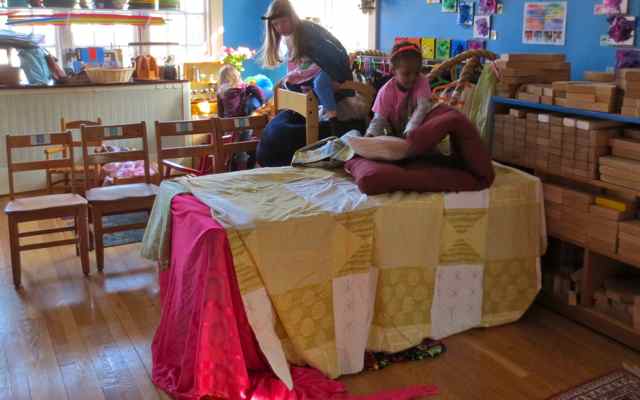Testing the Waters and Charting a Course
One of the players was sitting in a rocking chair gearing up for the princess game taking shape in the room around her. The princess game also involved ice queens and all of them were vying for real estate -- the real estate was defined by bedrooms. These royals were mostly focused on swooping around and sleeping. A lot of the play was about building beds in bedrooms and fastening scarves around their heads. As you read the following dialogue, please insert pauses between each word, question, and answer. Imagine these two children kind of looking at each other, but mostly looking inside their own heads -- looking for meaning, for implications of the buy-in, and mostly imagine that while their conversation was tentative and measured, they were open to the negotiation.
"I am the princess and I am going to marry the prince," she said brightly. She was adjusting her dress and scarf while sitting in the rocking chair. She had already used almost every piece of fabric she could find to create a canopy bed plus room using the large table in our dramatic play space. Her room was under the table. The space on top of the table had been claimed by a different princess.
"How about you marry a queen?" The question came out tentatively, the words like toes checking the temperature of the water in a swimming pool. Will it be too cold or just right?
The rocking kind of slowed down. "Who will be the queen?" the princess asked without looking up.
Now, in the dramatic play swimming pool water testing method THIS question forces a decision. The other child must decide..."Will I jump in, all in, who cares the temperature? Or, will I just barely touch the water with my toes?" Well, she jumped in. All in.
"I will be the queen."
Interestingly, they had not really made eye contact this whole time. They were just circling around each other in a negotiation all while sitting and standing.
"Alright," came the answer. And then our water tester decided to SWIM and she knew exactly what she was swimming towards.
"When you get married, you sleep in the same bed."
Suddenly I saw it plain as day -- I could see what the negotiation was all about. As the other queens and princesses swooped around and vied for real estate, the builder princess had laid claim to the best, best castle-bedroom-bed, EVER by building it herself. And our newly married Queen had negotiated an effective share of this best, best space without ever asking. "Can I...?" Her reasoning and proposal were sound and made perfect sense.
Now here is another interesting tidbit for us to add to this discussion -- it is about how we purposefully work to help the children chart a course for play AND become confident enough to test the waters and even to jump in, all in!
Earlier, I had told the children, and actually for several sessions prior to this, that they could not use the hollow blocks or the unit blocks for dramatic play. This forces a negotiation with me. We sit in our pre-dramatic play meeting and I make this announcement about the blocks. The children take this earnest and quick look around, "what's left?" Then they begin negotiating for the cardboard tubes, the fabrics, the pool noodle swords, the carpet squares, etc. We arrive at buy-in with materials and this models the negotiation of play. They practice, with me, the art of the give and take and almost as important, by removing a key ingredient of the familiar, the children create new play arcs with different players.
The removal of something, tried and true and all-too familiar, forces the cutting of a new channel and the children must chart a new course. Sometimes the changes will be small and perhaps unnoticed, but other times, you see the all-in, full body splash and swim. Joy!
